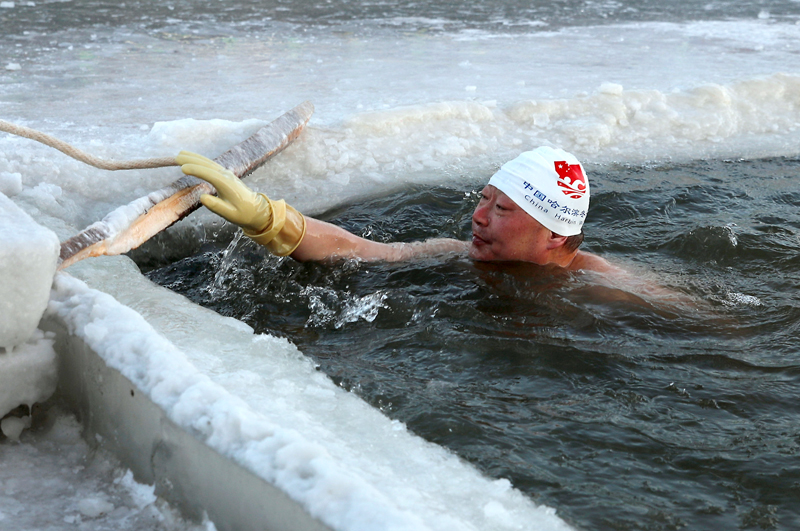You are viewing 1 of your 1 free articles. For unlimited access take a risk-free trial
High-altitude eating
Follow this eating plan to stop high altitude getting you down.
Altitude training has been a popular (if controversial) option ever since the 1968 Olympics held in Mexico (at 2,300 metres). While it seems clear that training at altitude will be beneficial for competing at that same altitude, some studies have found that athletes have failed to improve their sea-level performance (see also What The Papers Say, page 9).
Of course, there are reasons for being at altitude other than deliberately seeking out elevated climes for training purposes. You may be at a high altitude because that's where your sport is taking place! Mountaineers, skiers and cyclists racing in mountainous areas all have to contend with rarefied oxygen levels.
Whatever your reason, if you're participating in sport at altitude, beware. There's a real risk of malnutrition - living and exercising at altitude can lead to loss of body weight and muscle. This effect is more marked the higher you go, and the longer you spend in the reduced-oxygen environment. For example, there have been reports of weight losses of 3 per cent in eight days at 4300m and up to 15 per cent after three months at 5300 to 8000m. Also, there are short-term problems of acclimatisation to tackle. You need to know how to adjust your diet to minimise these problems. The key requirements are an increased calorie and fluid intake, and eating foods with a high carbohydrate content (Nutrition and Energetics of Exercise at Altitude. Sports Medicine vol 17, pp309-323).
Let's look at both the immediate and long-term effects, and what you should do to compensate.
Short-term acclimatisation
About one in three people are particularly susceptible to changes in altitude, and are in danger of suffering some form of mountain sickness. If this is the case for you, you need to allow a longer time to acclimatise. The immediate symptoms of mountain sickness include headache, nausea and lethargy. These initial symptoms are almost exactly like an alcohol hangover. More serious symptoms include loss of coordination, breathlessness and mental confusion. Anyone starting to notice problems of this latter type should descend to a lower elevation as soon as possible, and seek medical treatment, which will include being given extra oxygen and drugs to reduce brain swelling.
Ideally, you should try to avoid flying direct to altitudes over 9,000 feet (3,000 metres). Similarly, try to avoid progressing too quickly to altitudes above this level. When ascending to higher altitudes, you should spend tte or four days between 10,000 and 12,000 feet, waiting until you feel stronger and less breathless. Do the same for the next 2,000 feet, and then allow three to four days for each additional 1,000 feet. When you are acclimatised, you will still need to take more rest.
It' s well known that during acclimatisation, people tend to reduce the amount of food they eat. In fact, if the altitude exposure is too sudden, full-blown 'acute mountain sickness' may lead to loss of appetite, nausea and vomiting. The precise cause of these symptoms is still unknown, although there is increasing evidence that it may be due to variable degrees of cerebral oedema (water on the brain).
During this acute period, you should take care to drink plenty of water - the body loses copious amounts of sweat in the high, dry environment. Alcohol isn't a good idea in the first few days at a high altitude location. Finally, try to ensure that your food (if you can face eating!) is packed with carbohydrates. It might be worth taking some carbo-loading drink sachets with you so you can supplement your food intake.
Longer term
It used to be thought that the loss of weight observed at altitude was due to impaired absorption of food from the gut. However, it now appears that up to altitudes of around 5500m, this is of minimal relevance. It is possible that at extreme altitudes (above 6500m), the gut may lose some of its ability to absorb nutrients, as a result of the very low oxygen pressure.
In fact, the weight loss which has been noted at intermediate altitudes (2-4,500 metres) is more likely to be due to a combination of increased metabolic rate and poor intake of food. Basal metabolic rate (the amount of energy used to just keep your body ticking over) appears to increase during the first days at altitude. One research study found a 28 per cent increase in the BMR of women and men at 4300m. In other studies at 3650 and 3800m respectively, increases of 6 per cent and 10 per cent have been reported. With time, the increase in BMR subsides but does not appear to return completely to baseline values. A continued elevation in BMR at high altitude would lead to an increase in overall average daily metabolic rate. If such an increase is not matched by an adequate rise in energy intake you will lose weight. This may be fine if you've got plenty of padding to spare. But if you're already a lean machine, your body will start burning muscle for fuel.
Although there is therefore a physiological basis for weight loss, the problem is also likely to include a pragmatic element. It appears that comfort and palatable food play an important role in maintaining adequate food intake at high altitude. In a different country, the problem may be a simple one of not being able to find enough appetising food to eat ! For example, in some Himalayan areas, the local tea, made with butter and salt, may be a taste that takes quite a while to acquire, as is the staple barley flour munched dry alongside the tea.
In a study at the Italian Research Centre in Nepal, eight healthy men were measured for their body and muscle mass before, during and after a one-month stay. Despite the high altitude location (SOSOm), only a very slight body weight loss was observed, and this was thought to be caused by loss of body water due to the drier environment. A wide choice of 'palatable foods' were available, which the researchers felt helped the men to keep up, and increase, their calorie intakes (Int J Sport Med vol 14, pp244-247).
This study confirmed earlier ones where weight loss at altitude had been minimised by increasing energy intake. Therefore, if you're going on a high- altitude sojourn and are not sure about how keen you're going to be to tuck in to the local food, it's a good idea to take some food with you, if you have the means. Dried meals such as those available at camping and outdoor outlets would be suitable, as would be dried fruit and drinks devised to be made up as meal replacements. Try to eat more and smaller meals, and snack on carbohydrate-rich foods.
Don't neglect fluids
Extra fluid intake continues to be crucially important. The higher the altitude the lower the humidity and the quicker sweat evaporates from the skin. This can lead you to think that you're sweating less than usual - whatever you do, don' t drink less than usual ! Although your body will adapt to an extent after a while at altitude (eg, there' s a decrease in the water vapour content of air breathed out), there will still be a net increase in fluid requirements. It's also a good idea to cut down on caffeine and alcohol, as both are diuretics, encouraging loss of fluid.
Heavier reliance on carbos
Wherever you are, as an active athlete, you boost your capacity for endurance by eating a high-carb diet. But this becomes even more critical if you soar to high altitude. During both short and long-term altitude exposure, there is a decrease in the use of fat as an energy source, together with an increased reliance on carbohydrate. It's thought that this shift makes it easier for oxygen to dissolve into the blood. Thus, there' s a need for an even higher carbohydrate intake than usual. At altitudes over S,OOO metres, experts have recommended that carbohydrate foods should be increased to as much as 70 per cent of total energy intake. A number of researchers have found that people spontaneously increase their carbohydrate consumption when at high elevations.
Muscle maintenance
Becoming weedier isn't something you need to worry about if you're only at high altitude for a week or so. But if you're spending months in an extremely lofty climate, your muscles may well shrink. For example, mountain climbers have been observed to loselS per cent of their thigh muscle cross sectional area after spending two months at altitudes greater than 5500m. However, the same effects have not been seen at intermediate altitudes (2-3,000 metres). For example, athletes training for two weeks at 2100m had their muscles assiduously measured before and after the event. Some muscles increased slightly in mass while others decreased; this was explained as a result of different primary training modalities - running vs cross-country skiing (Limb Skeletal muscle adaptation in athletes after training at altitude, Journal of Applied Physiology vol 68, pp495-502).
Acute low oxygen depresses the rate at which muscle protein is made, and may increase the rate of protein breakdown. It's thought that for altitudes lower than SOOOmetres, making sure that you're getting enough calories will protect your muscles from actually decreasing in mass. When the body is strapped for calories it turns to breaking down muscle to provide extra energy.
At extreme altitude, it's been suggested that the loss in muscle could be a result of 'detraining'. For example, mountaineers in intensive physical training before an expedition might be expected to decrease their muscle mass at altitude because of a relative lack of exercise. An imaginative study which simulated a climb of Mount Everest found that there appeared to be a decrease in physical activity at very low barometric pressures (Operation Everest II: structural adaptations in skeletal muscle in response to extreme simulated hypoxia. Acat Physiol Scandinavica vol 142, pp421-427). However, a detraining effect would not account for the totality of muscle mass reduction which has been observed.
Finally, supplements of branched chain arnino acids (leucine, isoleucine and valine) have been found by some researchers to prevent loss of muscle at altitude. These can be used as an energy source by muscles while exercising.
There' s some evidence that supplementation with vitamin E improves exercise performance at altitude. The evidence isn't conclusive as yet. Food sources of vitamin E include vegetable oils, nuts and seeds. Anyone taking blood-thinning drugs should not take vitarnin E supplements unless closely supervised by their doctor, as the combination could lead to excessive bleeding.
Key points
1 Load up on carbohydrate foods before you leave, and continue to prioritise them when you're at higher altitude.
2 Drier air means you're at more risk of dehydration at high altitude. Drink more!
3 Your body will need more calories than normal. Add on extra carbohydrate foods and snacks.
4 Eat smaller, more frequent meals.
5 You'll burn more carbohydrate than usual. Eat more starchy and sweet foods.
6 Vitamin E and branch-chain amino acid supplements may be helpful..
Janet Pidcock
Newsletter Sign Up
Testimonials
Dr. Alexandra Fandetti-Robin, Back & Body Chiropractic
Elspeth Cowell MSCh DpodM SRCh HCPC reg
William Hunter, Nuffield Health
Newsletter Sign Up
Coaches Testimonials
Dr. Alexandra Fandetti-Robin, Back & Body Chiropractic
Elspeth Cowell MSCh DpodM SRCh HCPC reg
William Hunter, Nuffield Health
Keep up with latest sports science research and apply it to maximize performance
Today you have the chance to join a group of athletes, and sports coaches/trainers who all have something special in common...
They use the latest research to improve performance for themselves and their clients - both athletes and sports teams - with help from global specialists in the fields of sports science, sports medicine and sports psychology.
They do this by reading Sports Performance Bulletin, an easy-to-digest but serious-minded journal dedicated to high performance sports. SPB offers a wealth of information and insight into the latest research, in an easily-accessible and understood format, along with a wealth of practical recommendations.
*includes 3 coaching manuals
Get Inspired
All the latest techniques and approaches
Sports Performance Bulletin helps dedicated endurance athletes improve their performance. Sense-checking the latest sports science research, and sourcing evidence and case studies to support findings, Sports Performance Bulletin turns proven insights into easily digestible practical advice. Supporting athletes, coaches and professionals who wish to ensure their guidance and programmes are kept right up to date and based on credible science.









